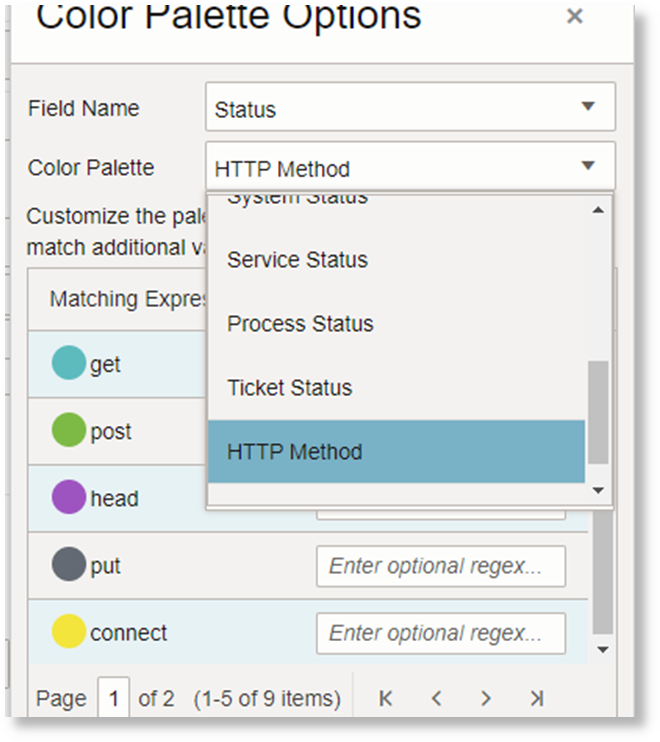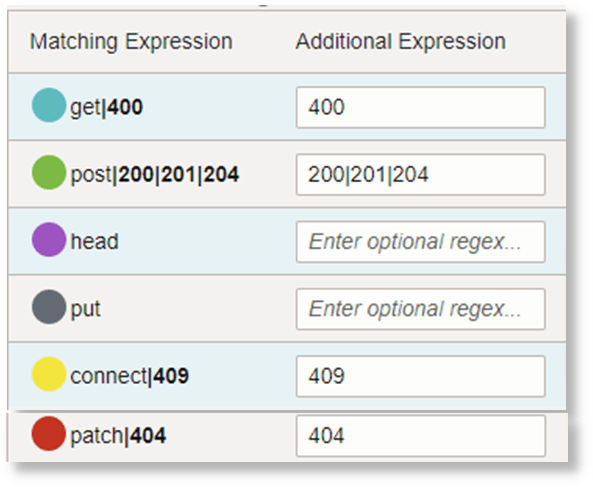Use timestats Command to Plot
a Time Series
The timestats command, when used after the
link command provides additional time series analytics and rich
visualization.
Topics:
In the following example with OCI Integration Activity Stream Logs, the Time Taken Trend is plotted on the basis of the fields Action and Integration:
Duration != null and 'Log Source' = 'OCI Integration Activity Stream Logs'
| eval 'Duration (ms)' = unit(Duration, ms)
| link Identifier, Instance, Action
| stats unique(Integration) as Integration
| timestats name = 'Time Taken Trend' avg('Duration (ms)') as 'Time Taken' by Integration, Action
You can hover on any data point to get the top values for that time period.

For the details of timestats command and a detailed use case of
plotting time series using the command, see timestats and Time Series Analysis Using timestats Command.
Understanding the Link timestats Syntax
In the detailed time series use case Time Series Analysis Using timestats Command, the following query is used:
'Log Source' = 'OCI VCN Flow Unified Schema Logs'
| link span=1day Time, Action
| timestats name="Trend of Action" sum(Count) as Records by ActionParts of the timestats command in the above example looks as
below:

The following parameters can be used in the command syntax:
| Parameter | Description |
|---|---|
name |
The optional title for the chart. If this is not provided, then the Y-axis name is used. |
span=<interval> |
An optional interval like 10min or 1hour. The
values are rolled up to this interval using the specified function.
By default, the span specified for the link command is
used. The chart will not align properly if different spans are
specified for the link and
timestats commands.
|
field |
Name of a timestamp field for the X-axis. This field is optional.
The default is Start Time field.
|
<function> |
Name of the function. You can use the functions that are
associated with the stats command with the
timestats command too. For details about the
functions and the examples of using the functions with the command,
see stats.
Use comma to separate multiple functions. For example: Each function will create a new chart. You can use the correlation option in the UI to visually correlate the charts. |
as <alias> |
Provide an optional alias for each time series. |
by <field> |
The function is computed for each distinct value of the specified
field. You can specify more than one field.
All the by-clause values for a given function are plotted on the same chart. There will be multiple charts if you have more than one function in your timestats command. Note: The number of group by fields is limited to 4. |
Using the Fields in the Link timestats
There are two types of fields that can be used for a timestats function:
-
Property field: Any field that is used in the
linkcommand, or created usingstats,eventstats,eval,lookup,nlp, ordeltacommands afterlink. -
Log record field: A field that is defined in the log source, and exists in the log record. You can directly refer to such fields from a timestats function.
Only property fields are allowed in a by-clause. Large fields like Message, Original Content, Error Stack are not allowed in a function or in a by-clause.
Charting a subset of logs: Use the addfields command to generate charts for a specific subset of data. The fields
used in addfields must be a property field. The following example
illustrates the use of addfields:
*
| link Time, 'Log Source'
| addfields
[ * | where 'Log Source' in ('Linux Audit Logs',
'Linux Secure Logs',
'Linux Syslog Logs',
'Linux Cron Logs')
| timestats name = 'Linux Logs' sum(Count) as Records by 'Log Source'
], [ * | where 'Log Source' not in ('Linux Audit Logs',
'Linux Secure Logs',
'Linux Syslog Logs',
'Linux Cron Logs')
| timestats name = 'Non Linux Logs' sum(Count) as Records by 'Log Source'
]Specifying the number of charts to be returned: Use the
topcount or bottomcount parameters to specify
the number of charts to be returned back to the UI.
topcount: When grouping by fields, return N count of distinct groups with the largest aggregated values.bottomcount: When grouping by fields, return N count of distinct groups with the smallest aggregated values.
For example:
*
| link Time, 'Log Source'
| timestats topcount = 3 name = 'Top 3 Log Sources by Count'
sum(Count) as 'Log Records'
by 'Log Source'
| addfields
[ * | where 'Log Source' in ('Linux Audit Logs', 'Linux Secure Logs', 'Linux Syslog Logs', 'Linux Cron Logs')
| timestats bottomcount = 3 name = 'Bottom 3 Linux Logs'
sum(Count) as Records
by 'Log Source' ]The following charts are generated as the result of running the above query:

Limits for Time Series
-
Number of fields in the by clause: Only up to four fields are allowed in the by-clause.
-
Allowed Fields: Refrain from using large fields in the function and in the by clause. Examples of large fields include the Message field, Supplemental Details, Error Stack and Original Log Content fields.
-
Null Values: Timestats aligns the values in the link table using the values in the Start Time column. For example, a Duration field may have values only for 10:06 AM, 10:10 AM and 1:12pm. As part of the alignment, a timestats avg(Duration) command would average the 10:06 AM and 10:10 AM values into a single average for 10:00am. Since there are no values for 11am and 12pm, they are filled with zeros. The 1:12pm value is placed at the interval 1 PM.
The actual alignment interval depends on the interval used for the query. An interval can be explicitly specified using the span parameter.
-
Number of time series values: Only 100 series per timestats command is returned. Here are some examples that illustrate this limit:
- The command timestats sum(Count) as Records by 'Log Source' returns only the top 100 Log Sources. The top 100 are identified by first sorting the values of each Log Source time series, and then sorting these time series. This means, if Records for a Log Source contains all zeros and a single large spike, then that is included in the returned results.
- The command timestats sum(Count) as Records by 'Log Source', Label returns the top 100 unique combinations of the Log Source and Label.
If partial results are returned, then an info icon next to the time series indicates the total number of series generated.
The following are some of the options to handle large number of time series values:
- Use the
addfieldscommand to filter the specific values to be used in timestats. - Use
topcountorbottomcountto return the top 100 or bottom 100 charts. - Use the
timeclustercommand to cluster the time series. This reduces the number of charts, since only representative samples are returned.
Configuration Options for the Time Series Charts
Similar to the histogram charts, the following options are available for you to
explore using the charts. Click Chart Options icon ![]() :
:
-
Hide / Show Charts: You can hide or show a chart.
-
Selecting the Chart Type: You can select from different chart types.
-
Adjusting the Chart Height and Width: You can increase the height of the chart using the Height option. Drag the Width control to increase or decrease the width of the charts. If there are more than one function, then reducing the width would cause more charts to be displayed in the same row. At full width, all the charts are displayed in individual rows. Reducing the width causes the charts to be arranged in multiple column order.
-
Correlating across Charts: You can use the Chart Option Show Correlated Tooltips to show correlated tool tips across charts.
Additionally, you can also use the following options to configure your charts:
-
Legend Control: You can turn on or turn off the legends using the Show Legend option in Chart Options.
-
Chart Filters: You can use the filters to interactively analyze the time series. Enable the filters by clicking Chart Options, Filters, and Show Search Filters. The filter options show the list of fields used in the timestats chart. You can select one or more fields to be displayed in the Filter panel. After you select the Filter options, the fields generated by the timestats command as well as the fields used in the by clause are displayed above the chart.
Select one or more filters to view only those specific data points. You can reset the filter selection by toggling the Select All option.
-
Search and Customize Filters: Click Options icon
 next to a filter name to view the complete list of values for that
filter. You can enter the text for search. You can also provide regular
expressions for searching. For example, searching for
next to a filter name to view the complete list of values for that
filter. You can enter the text for search. You can also provide regular
expressions for searching. For example, searching for e$will show all the results that end in the lettere.Check the Invert option to display only those values that do not match the criteria.
-
Select Colors: You can configure the color for each time series.
Consider the following query that shows the trend of each
Statusin the OCI Audit Logs:Status != null and 'Log Source' = 'OCI Audit Logs' | link Time, Status | timestats sum(Count) as 'Number of Hits' by StatusThe chart displays the Status values and their default color. The values of the Status field are
200,201,404,409,204, and400.
Enable the filters using Chart Options to view the color option next to the chart.

Click the Color link, select
Statusfield, and select a palette that has as many colors as the values to configure.
Update each color expression with the value or a regular expression you that want to match.

You can repeat this process for each field in the Color drop down to configure the colors.